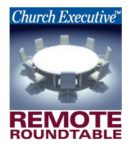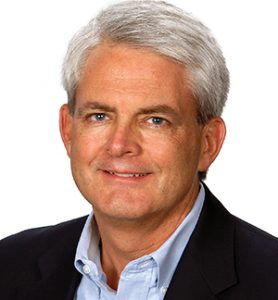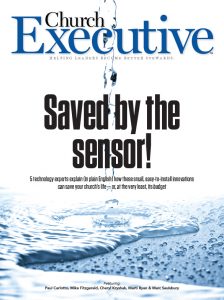
 5 technology experts explain (in plain English) how these small, easy-to-install innovations can save your church’s life — or, at the very least, its budget
5 technology experts explain (in plain English) how these small, easy-to-install innovations can save your church’s life — or, at the very least, its budget
Recently, Church Mutual partnered with Hartford Steam Boiler (HSB), a Munich RE company, to offer a state-of-the-art sensor technology program to houses of worship. It makes a lot of sense, for a lot of reasons.

Insurance Committee Member, New England Conference of the United Methodist Church
First United Methodist Church of North Andover MA
For a pastor who’s just learning about the availability of this sensor program, can you explain what it is, and what it does?
Carlotto: It’s a really good way to use technology to warn you when you have a condition in your building, whether you’ve lost heat or have too much water somewhere. A sensor sends a text, email or both to the appointed person in the congregation. He or she can respond to that text and go to the church, hopefully preventing a lot of damage.
Kryshak: That’s a good explanation. I’d add that the sensors are small and easy to install, and the warnings for temperature are two-fold. First, you get a warning when temperatures are starting to fall. Then, when they really are a problem, you get another alert.
Saulsbury: Right. It gives you real-time visibility into the conditions at your church. It’s this real-time nature of the information that’s new.
What are some of the biggest benefits to church facilities in using
this technology?

Senior Analyst
Celent
Carlotto: As chair of the board of trustees at our church, I learn sooner that I might have a problem, and it lets me react right away. We have only a few people — trustees — who could pitch in to help if we had to clean up water, or whatever it happens to be. It’s just a lot simpler (and cheaper) to catch it in the beginning than to correct it afterward.
Saulsbury: Yeah, exactly. The speed is critical in these situations, obviously, to help mitigate the severity of any loss you might have.
On top of that, the hope is that it’s just easier; rather than actively requiring you to constantly keep tabs on things, you get an alert or notification at just the right time. And we’ve tried hard to make sure the notifications aren’t overwhelming, so you’re not constantly having to respond — only when you need to.

Vice President Risk Control
Church Mutual Insurance Company
Fitzgerald: Among analysts, we’ve been talking about ‘Internet of Things’ technology and how it’s going to change the meaning of insurance, the value proposition. This is a great example of that. Basically, instead of the traditional insurance value (‘We’ll write you a check once something has happened to make you financially whole’), this is moving that indemnity model to one of avoidance and mitigation. That adds huge value.
Kryshak: Another interesting thing about the program is that it notifies you even in situations not covered by insurance. We had a scenario where someone left a window open in a basement, and there were torrential downpours. Water came right into the building. Unfortunately, that wouldn’t be a covered loss; but because of the sensor, they were alerted, closed the window and mopped up the water without a much bigger mess.
Carlotto: Same here. We had some pretty bad weather in New England last

Assistant Director
The UW Internet of Things Systems Research Center
year. In our choir room, someone didn’t close the window all the way. Nobody saw it, and we had very strong winds that night. At 11:15 p.m., I got a notification about the temperature in the choir room being low, so I went down to the church. Even before I got into the room, I could feel air blowing all around. I found the bottom sash had come out of its track, and the space was quickly losing temperature. I was glad to have the technology, because I wouldn’t have wanted to come in the next day and find a huge mess.
Kryshak: You make a really good point, because it’s not just about pipes freezing; it’s also about energy efficiency. Without the sensor, your furnace would have just kept running [to maintain the temperature in the room], which would have been expensive.
What is it about church facilities that make them particularly good candidates for Internet of Things (IoT) technology solutions like sensors?
Ryan: From my perspective, it’s almost like a vacation home; the comings

VP Strategic Business Development
Munich RE/HSB
and goings are at various times, and various people need to manage the facility. I think sensors are a great way to provide collaborative management of a building, from a distance, across many users.
Saulsbury: That’s a great point. The occupancy and use of a church are like that, where there are long stretches when no one is in a particular room, or even in the building.
Another thing is [as Kryshak noted], churches are cost-conscious. Big sensor networks and large, sophisticated equipment have been around in the industrial space for many years. It’s only now that it’s getting so much cheaper, and the sensors themselves are much smaller and more accessible to everybody.
Kryshak: I would add that the individuals who are usually taking care of the church are volunteers. They have so many other personal responsibilities. This technology can keep them apprised of what’s going on without them needing to be on-site.
 Fitzgerald: One thing also to mention is that many church buildings have some age. They might even be historic, which can make their valuations priceless. This makes it particularly beneficial to have this type of sensor monitoring in place.
Fitzgerald: One thing also to mention is that many church buildings have some age. They might even be historic, which can make their valuations priceless. This makes it particularly beneficial to have this type of sensor monitoring in place.
What are some of the costs — “real and soft” — that can be avoided by using sensor technology and IoT solutions?
Carlotto: In 2010, we could have avoided about $350,000 in damages at our church if we had sensors in place. On a Saturday afternoon, our 5-inch water line — the main line for our sprinkler system — ruptured. It basically filled up the subfloor of our 6,000-square-foot facility, which houses four classrooms, our mechanical room, closets and some bathrooms. It ran for at least five hours and was only discovered when somebody stopped by the church. They were greeted by 4 feet of water flowing out at them.
Kryshak: What a mess.
Carlotto: Yeah. So, we lost our two boilers and everything in the Montessori classrooms. The whole basement level basically had to be rebuilt, and we couldn’t run our sprinkler systems, so we had to leave the building. We ended up going to another church for about six months. Because of that, we lost people who didn’t come back.
Ryan: One thing I would add to [ Carlotto’s ] experience is that while there’s a quantifiable cost savings, one of the soft benefits is peace of mind.
Saulsbury: That’s an excellent point. It speaks to [ Fitzgerald’s ] comment about how insurance is changing. The value proposition insurance companies want to bring to the table includes things like peace of mind, comfort and visibility. Also, as [ Kryshak ] mentioned, energy and cost savings.
 Can you comment on other building control advancements and how they could positively impact a church’s bottom line?
Can you comment on other building control advancements and how they could positively impact a church’s bottom line?
Fitzgerald: There are systems now which are much more interactive in terms of how property is used. Even in the home, hooking up Alexa to a light switch means you don’t have clap anymore! [ laughs ] You can just say, “Turn on,” and it’s on.
This generates data that can be captured, stored, analyzed, and turned into meaningful information — information you wouldn’t have otherwise. So, if you get a smart building, you can do smart management of that facility.
We’re going to see increasingly easy-to-use platforms — not just to turn the lights on and off, but to actually interpret how a building is being used currently, and how it can be optimized.
Ryan: Well, you’ve definitely hit upon it. And, some sensors you could add are for smoke, fire and CO2. I bet even attendance-counting could be also sensor-triggered, not to mention the optimization of HVAC and lighting.
It’s becoming very sophisticated. There’s a lot of movement in quantifying buildings, and how to maximize and optimize them.
For church leaders who might be hesitant to try new technologies, how easy is it to install and use the sensors?
Carlotto: I was with the tech at our church when he installed it. It’s very simple, and I’m sure I could probably do it myself without any problem.
Kryshak: Yes. Really, it’s installed using Velcro strips, so probably the most difficult part is figuring out where to put the sensors; we give a lot of advice to that end. We also have monitoring and support available to anyone who has a question. If you’re in the middle of putting it together and you get lost, we have somebody available on the phone to walk you through it.
Ryan: From our experience, we just sent a kit of smart and connected devices to 30 households across Wisconsin, and didn’t give them a lot of instructions on installing them. In each kit were motion sensors, electric outlets, water leak sensors, and a smoke and seal alarm. The average time to install those devices was between 60 and 90 minutes.
Why is a wireless platform so important to sensor technology and other IoT solutions?
Saulsbury: I think churches — in terms of occupancy and use — are a perfect corollary as to why this sensor technology is helpful. We talked about how some churches are pretty big buildings, so there’s the distance issue. There are also challenging construction materials to consider. But wireless technology adapts to those elements.
Another consideration is security. Our church installations so far have been based on cellular networks; we purposely don’t connect to an existing network, for security reasons. We call it ‘network segmentation’ — it puts it on an entirely different network and doesn’t expose any of the church’s existing data.
Fitzgerald: If you really want to experience why wireless is important, go spend 30 minutes in the boiler room. So many places where you need sensors are inaccessible. You wouldn’t want to be running a wire or be worried about maintaining a wire in some of those spots.
From your perspective, what would you like to see — or what other innovative solutions do you see coming along — that would benefit church facilities?

Carlotto: While we were talking, a few needs came to my mind. One of them is for when my church loses electricity.
I live 25 minutes away; so, if the power goes out, I’ve got a couple issues. If it happens during the day and I lose heat, then the Montessori School can’t stay there. If I lose power to my air compressor — which keeps my sprinkler system charged with air — and everything trips and the system floods, then the fire department will show up and I’ll have lines full of water. The sprinkler service company will have to come in to drain the lines and reset everything, which costs $550 minimum each time.
Also, it would be great to have some kind of sensor that would tell me if one of our 15 hot-water circulators for our baseboard heat goes down. Right now, I wouldn’t know; nobody would. I’d like something that could monitor those kinds of things.
Kryshak: Actually, [ Carlotto ], you should be getting an alert if the power goes out. The reason we know that is because your gateway is plugged in. When that gateway doesn’t get the electric power anymore, it goes to battery; at that point, you should get an alert that says the battery is being used, meaning you have no power — at least not to the gateway. Does that mean that the entire power went out in the whole building? No, I can’t say that. So, there’s something in place already, but certainly not to the extent that you’re looking for. That’s really good feedback for us.
Another need we’ve been hearing from customers centers around fire. We have sensors that alert when temperatures go really low, so we need to develop something for when the temperature goes really high. That way, somebody can get in there right away.
Saulsbury: What you’ve both said illustrates kind of a neat secondary effect: the sensor technology, once it’s installed, allows you to do a lot more than what you initially put it in for.
On top of that, we’re always looking to incorporate other data sources. I believe [ Fitzgerald ] mentioned there’s all this new data that’s being created. If we could compare or correlate that to things like weather data and other outside data sources, it could be helpful. In the event of a power outage, for example, there’s some data that could tell you if the neighborhood is down.
All of this is possible. But even these initial installations [ of the sensor program ] provide us a lot of opportunities to do some cool stuff.
— Reporting by RaeAnn Slaybaugh


